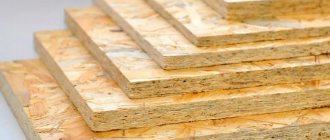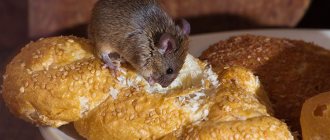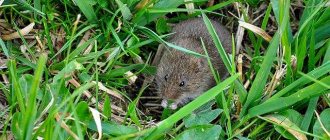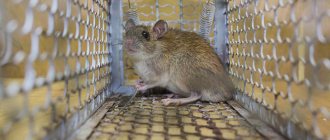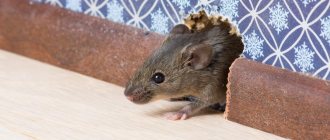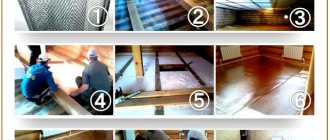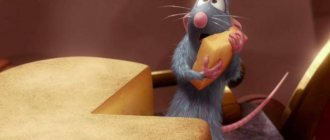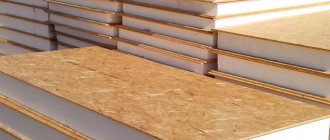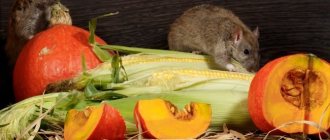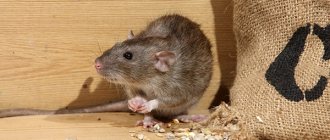How and what was used to insulate a house to prevent mice from getting in it?
Today there are different types of modern insulation on sale that we have never heard of before.
Old proven methods of thermal insulation are considered to be the use of expanded clay, slag and ordinary sawdust mixed with quicklime (fluff). Rodents will never enter a house insulated with such materials. The use of polystyrene foam, mineral wool or polystyrene foam will not protect your home from pests. Ultrasonic repellers, poisonous baits and mousetraps will help keep your home safe.
The harmful effects of ultrasound are not felt by humans, but this does not mean that it does not affect them. The safety of such devices for people has not been fully proven. Spreading poison poses a danger to pets and children, and mousetraps are ineffective. Interestingly, rodents are afraid of the smell of wormwood, so you can add leaves and stems of this plant to the insulation, but you will need a lot of them.
What is the reason
In fact, mice chew on polyurethane foam not because they are hungry and want to eat something before getting to more edible human reserves. There are more prosaic, but still vital reasons for this.
The first reason lies in the physiological characteristics of all rodents, without exception: the front incisors are constantly growing and, so that they do not interfere with normal food intake, they must be periodically ground down. So mice grind everything, including polyurethane foam, but don’t eat at all, as many people think.
The second point is household. Everyone knows that foam retains heat well and seals the room; in principle, it is thanks to this property that it is used in construction. House mice are not the stupidest creatures and quickly learned to use such useful material to build their own nest.
The third factor is the simplicity and ease of gnawing through passages. For safety reasons, domestic pests move around the house in a maze of their own making. It’s much easier to make a path and create a hole in polyurethane foam than in brickwork.
Pests in the barn
Rodents try to penetrate not only the house, but also any buildings in search of food. Therefore, residents of private homes are interested in how to get rid of rats in the barn on their own. In such a room they either keep large quantities of food for livestock, or for themselves. Therefore, there is always something for rodents to profit from.
Important! Their presence affects the health of birds, and as a result, productivity. Therefore, you need to get rid of impudent pests immediately
Chemicals
The easiest and cheapest way: just buy a pesticide and pour it into the place where it penetrates. However, everything is not so simple: pets can also be poisoned. It is unlikely that it will be possible to transfer animals from the treated area for 2-3 days, so this approach is risky. However, you can prepare traps: for example, put the poison in boxes where chickens, for example, will not climb.
There are several types of chemical poisons:
Use force
Rats are larger and much more dangerous than mice, so it is advisable to know how to get rats out of the barn using folk remedies before they cause trouble - these rodents take great pleasure in strangling chicks. Placing traps near their holes and installing special traps is a sure and effective way to catch pests. You can have several cats that are capable of hunting and killing rats: this ability does not depend on size at all. Fluffy mousetraps can be very miniature - it's all about speed and resourcefulness.
Traditional methods
To get rid of rodents, you need to make their stay in the barn unpleasant. This is even more effective than direct destruction - rodents multiply quickly and do not stop in front of traps.
- Stove ash scattered on the floor guarantees mice digestive problems;
- If no one lives in the barn, you can use mothballs or kerosene - this is a sure way to get rid of rats and mice in the barn.
- Holes in the walls need to be filled with broken glass and then filled with concrete. No polyurethane foam!
- Cruel method: a mixture of clay and flour will attract rodents, so water is placed nearby. The liquid causes the plaster to harden and the mouse dies.
- You can hang and arrange bunches of herbs - black root, the second name of which is rat-eater, is not felt by humans, but is destructive for rodents.
- Tansy, wild rosemary and peppermint - any of these plants will help get rid of rats and mice in your area.
Rodents destroy crops and livestock year after year and cause harm to humans
Being careful and taking timely measures will help protect yourself and your home from rats and mice.
Unreliable insulation - methods of protection
Factors indicating rodents
With regular frequency, rodents sharpen polystyrene foam, cellophane, expanded polystyrene, insulated linoleum, and penoizol. Therefore, the question arises of how to protect the insulation without nullifying all efforts to improve the facade.
- It is necessary to fasten dense sheets of any building material over the insulation. A frequently asked question is whether mice eat or chew plywood. It has no nutritional value; pests gnaw on it in order to further penetrate the premises. Since the layers of plywood are folded in a special way, pests cannot make through holes.
- If rats and mice chew on foam plastic, you must first get rid of the pests, then begin saving the walls. Broken glass is poured into the passages and glass wool is stuffed. You can use poison for rats and mice or involve a cat in this matter.
- Protecting the foam requires placing a reinforced metal mesh over the material. The work must be done efficiently so that there are no gaps or large holes between the sheets. You will have to tinker a little with such protection, but pests will definitely not get to the foam.
A folk remedy for protecting against the penetration of rodents is to treat the foam with boric acid. The substance remains on the surface for about 6 months; if it is all in the wall, much longer. But many doubt its effectiveness. It will not be possible to saturate a porous material with the solution.
The surest way to protect an unreliable material is to block access to it and make the wall airtight. You don’t have to completely cover the walls with metal mesh; a few centimeters from the bottom is enough.
Rodents can do more than just gnaw on polystyrene foam. They like to live within such walls. The material is safe for their health, warm, soft. The same feature applies to polystyrene foam. Mice can gnaw through passages, settle in walls, and build a nest.
Protecting foam from pests
Polystyrene foam is a very convenient material for thermal insulation and sound insulation. But it is various foam plastics that are most susceptible to attack by mice and rats. These are materials such as extruded polystyrene foam, polyurethane foam, penoizol, penoplex. These materials are artificial, so they are not suitable for mice as food, but they chew them and turn them into dust. In the resulting voids, rodents make nests for themselves. To protect it from rodents, you need to take certain measures:
- 1. You should choose dense types of foam for insulation, since it is inconvenient for mice to gnaw on dense material.
- 2. Proper installation of the foam is necessary. It must be carefully puttied and sheathed using special materials, selected individually. The goal of proper installation is to prevent the appearance of cracks, since rodents enter the home through the cracks.
- 3. All holes must be sealed with polyurethane foam.
- 4. It is advisable to provide metal sheathing along all walls at pest entry level. They won't be able to handle metal.
These measures must be taken into account at the construction stage. If they have not been accepted, all that remains is to take actions aimed at repelling rodents:
- 1. The easiest way is to get a cat. Just the smell of a cat in the house repels mice.
- 2. You can install an electronic repeller, but if the area of the house is large, one device will not be enough, you will have to install several. Such repellers emit ultrasound of various frequencies, which causes fear in rodents and forces them to leave the building.
- 3. All food supplies must be kept out of the reach of rodents.
- 4. The home must be kept clean.
Folk remedies are effective to protect polystyrene foam. They are based on the use of various plants that repel rodents with their smell. These are plants such as pine needles, tobacco, mint, wormwood. These dried plants can simply be scattered in corners. During the construction phase of a house, you can treat the foam with lime or red pepper.
Some people use boric acid to repel pests, but its effectiveness in controlling rodents has not been proven.
If none of the above methods help, you need to contact the sanitary and epidemiological station, whose employees will come and carry out a complete disinfection of the premises and the elimination of all rodents.
Protection and prevention methods
There is nothing special that can protect foam for installation from rodents. It is necessary to build a dense structure on top that mice cannot gnaw on. Fill the gap between the doors, nail a board of chipboard or other similar material on top. The fibers are arranged in such a way that mice cannot make a hole with their teeth.
To protect yourself, you need to follow the general rules for fighting mice - get a cat, use mouse poison, ultrasonic repellers, cage traps, traps. Any convenient way to prevent mice infestation.
How to protect the thermal insulation circuit from damage
If you got a house with a ready-made thermal insulation layer, or the mouse population suddenly began to increase, you need to take measures to protect the insulation. Otherwise, within a couple of years, heat loss will increase, and with it, heating bills will increase.
There are several options here that I would recommend implementing comprehensively:
- We protect all thermal insulation layers with dense material, preferably one that is too tough for a rodent.
- We fill the cavities and discovered passages with broken glass, wood shavings soaked in copper sulfate, or push glass wool.
- We store all food products and seed in a place inaccessible to mice. No food means no incentive to gnaw and seriously settle down in the insulated walls.
- We place poison behind the casing and in the corners, and install ultrasonic devices that repel rodents.
Well, and the most effective method, which, in addition to getting rid of rodents, has a bunch of other useful effects. Finally, get a normal cat, and every morning you will find several gray carcasses on the porch. Sooner or later the mice will run out and your insulation will be safe.
The cat, however, will stay and ask for food, but it seems to me that this is a completely acceptable price for peace and order in the house.
https://youtube.com/watch?v=CgTf7-OkKXE
How to protect polyurethane foam from being chewed through?
There are several simple ways to protect pliable and porous building materials from being chewed by rodents. To do this, when sealing the cracks with polyurethane foam, you will have to tinker a little longer, but overall it is worth it. These preventive measures are based on:
- adding caustic solutions during the sealing process between layers of polyurethane foam that will repel rodents;
- equipping the gap or holes with an additional physical barrier that mice will not be able to handle;
- adding small objects to the foam that can injure rodents when trying to chew through the frozen polyurethane foam.
Additional ways to protect yourself from mice and rats
If the thermal insulation layer has already been installed, and the problem with rodents has appeared recently, additional protective measures must be taken
It is important to prevent mice from accessing the interlayer. This can be done without dismantling the insulation
To create additional protection, it is recommended to use the following methods:
Installation of steel mesh. It is installed in front of the insulation. The method is expensive, but effective. The use of chemical compounds - “Rat”, “Goliath”, “Mortorate”. Processing is done in accordance with the instructions
It is important that the properties of the insulation do not change. The use of alternative thermal insulators. Rodents are afraid of sounds, so a layer of fallen leaves will scare them away.
Read about how to completely get rid of mice here.
Effective protection against pets
If we look at situations with pets, the main problem is not even the destroyed cord, which must be restored or replaced, but the fact that your pet can be electrocuted. Therefore, it is simply necessary to take all possible measures to protect not only the wiring from animals, but also the animals from the wiring.
Here are the main methods of protection:
- You can grease the wires with pepper in order to discourage the cords. Many people recommend wiping cords with detergents, but they can harm the animal;
- in veterinary stores you can buy a special product that, with its smell, drives pets away from “high-risk” areas;
- try to hide all cords by “covering” them with furniture;
- You can protect the cables by wrapping them with double-sided tape or tin foil;
- during repairs, provide for the passage of the cable line at such a height that pets cannot reach it;
- Apply simple training methods, every time the animal is about to approach the cord, interest it in the toy. Thus, an elementary reflex will help: when the pet sees the wiring, it will remember its favorite toy and look for it.
Insulation that will resist rodents
There are a number of criteria by which mice choose insulation material: low density, lack of moisture, warmth and the ability to be used as food. Therefore, to protect against rodents, these factors must be excluded.
Insulation that can resist attacks from rats and similar animals must have the following properties:
- High density. This is the main obstacle for rodents.
- Treatment with special agents, the concentration of which is safe for human health.
- Loose insulation structure. It prevents pests from making nests in the material.
These requirements are met by a number of thermal insulators, which need to be considered in more detail.
Foam glass
For the production of foam glass, broken glass is used, which goes through a heat treatment stage. To create voids, foaming agents are added - anthracite, coke. Subsequently, the formed hollow granules can be used as bulk material. To make blocks, they are poured into molds and then subjected to pressure and repeated processing at high temperatures.
When choosing foam glass as insulation, you need to take into account its properties (see all characteristics here):
- High specific gravity. Depending on the manufacturing technology, the density of the material varies from 100 to 600 kg/m³. This is a high indicator, which negatively affects installation and processing conditions.
- The thermal conductivity coefficient is one of the lowest among insulation materials - from 0.043 W/m*C. For bulk types of foam glass it is higher, since close contact of the granules with each other is not ensured.
- Fire safety and sound insulation. They are determined by the properties of the material of manufacture and its structure.
- High price. The average price for 1 m³ of block foam glass is 17,500 rubles.
This insulation is chosen if the problem of rodents is urgent and a high degree of protection against them is required.
Expanded clay
Expanded clay is made from special types of clay using a technology similar to foam glass. But unlike it, the formed granules cannot be compressed into a single block, since they have low mechanical strength and elasticity. This insulation is not chewed by mice and rats due to its flowability.
To analyze the relevance of using expanded clay, its characteristics are taken into account:
- The nominal thermal conductivity for one granule is from 0.01 W/m*C. But in fact, for the expanded clay layer it is higher, since “cold bridges” are formed between the components. It all depends on the density of the backfill.
- Compaction factor – 1.15.
- Fraction 10-20. It is this size of granules that is used for insulation.
- Water absorption from 8 to 20%.
- The average cost is from 1300 rubles per 1 m³.
Expanded clay can only be used as loose insulation on horizontal surfaces.
Ecowool
It is made from paper industry waste. After processing, ecowool is treated with compounds of brown salt and boric acid. Their concentration is dangerous for rodents, but does not affect human health. To apply ecowool to the surface of walls or floors, special pneumatic equipment is used. The final drying time of the protective layer varies from 2 to 4 days depending on its thickness.
Main characteristics of ecowool:
- Insulation belongs to the category of moderately flammable materials. When exposed to open fire, it does not melt; if the source of ignition is removed, attenuation is observed.
- Average density – up to 55 kg/m³.
- Thermal conductivity - up to 41 W/m*S.
- The price includes work on applying the material - from 600 rubles. For 1 m² with a thickness of 100 mm.
It is advisable to use ecowool for large volumes of insulation.
https://youtube.com/watch?v=CgTf7-OkKXE
How to prevent damage to insulation
As you can see, the list of “edible” materials covers all popular and frequently used insulation materials. However, even taking into account the great interest in them from rodents, they are used and very successfully. The answer lies in thoughtful insulation design and implementation.
The best option is a combination of materials. If you lay “inedible” material around the perimeter of the insulated space, and mineral wool or polystyrene inside, then protection against rodents will already be built, and the insulation of the house will not be affected.
If there is no way for rats to get into the mineral wool slabs, they will not settle there. As a barrier, reinforcement with barbed wire and fine-mesh mesh is used on all approaches from the foundation and roof, when it comes to walls. You can use broken glass and lay it underneath and on top of the insulation layer.
Special antiseptic compounds are often used, including borax, which can reduce the activity of rodents and repel them from the material. The main thing is to do all this at the installation stage, since otherwise you will have to deal with the consequences.
For especially dangerous and risky places, where you can’t get rid of the close attention of rodents, you should pay attention specifically to the insulation material, giving preference to its “inedibility”. https://www.youtube.com/embed/9WGCZ0c7Vck
Bitterness from mice
In Europe, a few years ago, polyurethane foam was developed with an extremely unpleasant taste for mice. It is also avoided by other unpleasant guests: bedbugs, cockroaches and rats. This miracle cannot be found in Russia, but you can try to make an analogue yourself. Of course, it is much better to immediately use the right and reliable materials, but situations vary.
Interesting! To protect the polyurethane foam, after hardening it is enough to spray it with a special aerosol, the range of which is always wide in hardware and construction stores. Such a simple protection system can work if the insulation does not constantly get wet, otherwise the entire effect will disappear very quickly, also spreading an unpleasant odor.
Do mice chew foam?
Giving the answer to this question, we say “Yes!” Polystyrene foam attracts gray animals for its search for food, comfort for housing and reproduction. At the same time, they disrupt the structure and functionality of the building material, turning it into dust. Damage can be up to 60%, especially for granulated polystyrene.
Mice don't care what material gets in their way. Walls insulated with foam plastic are one of the barriers to entry into the house
Rodents live in groups. Therefore, if you come across one specimen, there is no doubt that there are a dozen nearby.
Rodents are very thrifty. This is their basic instinct. This means that they will create a warehouse of mouse goodies within the walls of the house. It's easy to imagine what aromas will be in the air. The smell of rotting, which can ruin the living conditions of the owners of the house.
Why do mice chew inedible things, including different types of insulation?
Some types of insulation are considered conditionally edible for rodents, for example chipboard, reeds and polystyrene. By eating them, rats compensate for a long absence of food. The organic materials from which the insulation is made are perfectly digested and absorbed in their stomachs. Mice can chew polyurethane foam, fiberboard, MDF, and polyurethane foam, and this is due to their physiological characteristics. Rodents' incisors grow throughout their lives, so they have to be ground down regularly.
Not only thermal insulation materials are damaged, but also shoes, clothing, furniture, and wiring. Most of all, mice like to live in jute, inside mineral or basalt wool. The soft material holds its shape well, is ventilated and retains heat well. Treatment with special chemicals or boric acid will help protect the insulation from damage. Plywood and DSP boards, which are excellent for insulating a frame house, are not always susceptible to mouse teeth.
What ways are there to protect insulation from rodents?
Of course, the main reason for mice entering is the search for food, so neatness in everyday life will be extremely useful. Well, the recommendations and methods collected here will help:
- As a means of prevention, regular inspections of the facade can be recommended, especially during periods of rodent activity. The absence of cracks and holes, as well as their timely sealing, can save the house from major repair work and the owner from costs.
- The base profile is installed at the very beginning, as the bottom row of the plaster system. It is a metal strip that can protect fragile insulation and its lower edge from teeth.
- Installation of mineral insulation can, to a certain extent, protect the thermal insulation layer, since manufacturers emphasize the unattractiveness of mineral wool for consumption by rodents, insects and even microorganisms.
- Correct installation of thermal insulation with careful putty and the use of special weather-resistant building materials for finishing and protecting the insulation from rodents.
- Special cladding is a good protection option. Mice and other rodents can be stopped by wire mesh bars. However, any gaps left in the reinforcement can ruin the overall effect.
Mice chew on polyurethane foam, what to do?
Sometimes people amaze us with their shortsightedness, bordering on stupidity. For example, there are those who are sure that using ordinary polyurethane foam you can protect your home from mice. They selflessly clean cracks and holes, and rodents not only do not disappear, but also multiply exponentially.
In fact, mice chew on polyurethane foam not because they are hungry and want to eat something before getting to more edible human reserves. There are more prosaic, but still vital reasons for this.
The first reason lies in the physiological characteristics of all rodents, without exception: the front incisors are constantly growing and, so that they do not interfere with normal food intake, they must be periodically ground down. So mice grind everything, including polyurethane foam, but don’t eat at all, as many people think.
The third factor is the simplicity and ease of gnawing through passages. For safety reasons, domestic pests move around the house in a maze of their own making. It’s much easier to make a path and create a hole in polyurethane foam than in brickwork.
What to do
If mice get into the insulation, then it is problematic to smoke them out. Therefore, it is better to think about thermal insulation, which at the same time can serve as a barrier for rodents, in advance.
Experience suggests that pests do not favor the presence of the following materials, which in terms of useful properties are in no way inferior to polyurethane foam:
- expanded clay,
- foam glass,
- foam concrete,
- glass wool
Ecowool is considered the best anti-mouse material in construction today. Why it is called that is unclear, because 20 percent of it consists of components that are not the most healthy for health: boric acid, borax. It is these toxic substances that cause suffocation attacks in rodents.
There is an opinion that rodents are afraid of penoizol, styrofoam and the usual polystyrene foam, but as practice shows, mice not only gnaw it, but also use it perfectly to organize their own home and labyrinth.
If the foam has been purchased and it is not possible to replace it with an alternative material, then in this case there is a way out: during the work, the treated area is generously flavored with glass broken into fine crumbs.
Foam that mice are afraid of
By the way, news recently appeared that a certain European company has released polyurethane foam that can repel not only rodents, but also other household vermin such as cockroaches, bedbugs, etc. It does not contain pesticides hazardous to humans.
Miracle foam appeared abroad in March 2012, but it never reached the Russian construction market.
Although, if you try, you can make such foam yourself, because the bitter ingredient is not a secret, it is denatonium benzoate. The foamed surface is generously treated with the solution, and rodents may not want to try it on their teeth.
To the question: do mice chew polyurethane foam, the answer has been given. But whether to use it in construction or not is up to each individual to decide.
Will sealing mouse passages with foam work?
Do mice chew polyurethane foam if it is used to seal old mouse passages? According to the owners who tried to seal up mouse holes with this building material, this exercise is useless. If a mouse or rat has been walking here for some time before, it will easily restore its previous passage. All types of rodents that love to live at the expense of others, that is, mice, rats, dormouse, ferrets, can easily chew through materials such as OSB, chipboard, plastic and even brick. Therefore, such a porous and pliable material as hardened polyurethane foam is not a hindrance to them at all.
Do mice eat foam? Of course not. But that doesn’t stop them from grinding it into dust. Females often use this dust to improve their nests. The material retains heat perfectly, just what is needed for rats and mice that are soon expecting offspring.
About the use of insulation
One of the reliable insulation materials for the home, which retains heat well, absorbs noise, is non-flammable and inedible for rodents, is expanded clay. It is made from clay, which is cleaned, wiped, then granules are made from the resulting plastic solution, which are hardened at a certain temperature.
As it cools, expanded clay acquires light weight and is at the same time durable. It has small, medium and even large fractions – 10 – 25 mm in size. Mice and rats will not be able to exist in such material, since they will drown in the thinness of its particles. Expanded clay is used to insulate interfloor and attic floors and basements; it can be used for walls.
Foam glass, which is produced in slabs and in bulk, is also not eaten by rodents. In the loose version, it is similar to expanded clay and is used to insulate walls, floors, and ceilings of a house. It is customary to mount the slabs on the walls from the inside or outside, lay them on the floor, concrete, bitumen, construction adhesive or expanded clay having small fractions.
Foam glass is made by melting and foaming glass. The material is strong, durable, environmentally friendly, and has good resistance to moisture and ultraviolet radiation.
Ecowool is a fairly new material. Rodents do not like ecowool because it contains phosphoric acid, which causes dehydration and suffocation. Ecowool is made from cellulose, harmless to humans, antiseptic, fireproof, releases moisture when heated, muffles noise well, is not subject to rotting and decomposition, and is durable. Can be used both inside and outside the house.
Foam concrete is produced in mortar and blocks. Rodents don't eat it either. The blocks are suitable for construction and wall insulation. The composition of the material, which is used to insulate a house from the outside or is poured into the middle of the masonry during construction, includes water, sand, cement and a foaming agent. Used for thermal insulation of floors and ceilings. Light in weight, environmentally friendly, easy to process, non-flammable, and not subject to rotting.
Penoizol is foam plastic in liquid form. Spraying on the walls is carried out using a special compressor. Mice and rats happily chew this type of foam. In ordinary foam plastic, pests make nests and gnaw passages.
Penoplex is resistant to high and low temperatures, chemicals, possible deformations, resists moisture, transmits light, is environmentally friendly and safe for human health. Extruded polystyrene foam is strong and lightweight, used for thermal insulation, sports fields, ice arenas and refrigeration equipment.
What types of insulation do mice not eat?
The building materials market offers consumers a wide range of insulation materials.
And what’s important is that there are materials that mice won’t chew on. But if gray rodents already live in the insulation, then it will be very difficult to drive them out
Foam concrete
It is a rigid, but at the same time lightweight and porous thermal insulator. Rodents will not be able to chew holes in it.
Buildings made from foam concrete are very warm, durable and environmentally friendly for residents.
Please note: walls are insulated with foam concrete only from the outside, in order to avoid the formation of condensation and mold.
Expanded clay
Expanded clay is a very reliable, non-flammable and time-tested material. It is made from special types of clay. Granule sizes vary from 1 mm to 40 mm.
This insulation is used to insulate walls and floors. It is difficult for rodents to live in expanded clay. It is difficult to move there, there is not enough air, small parts can clog the respiratory system.
Ecowool
In the production of this insulation, orthoboric acid is used. The acid can cause lung damage, dehydration and even kill rodents. Ecowool is not a dangerous material for humans. Therefore, it can be used to insulate both external and internal surfaces.
The insulation has excellent functions of heat and sound conductivity, fire safety. The service life is at least 50 years. Ecowool is not subject to decomposition and rotting processes.
Foam glass
One of the materials that rodents do not like and therefore do not grow indoors is foam glass. It is produced by foaming glass and soot.
The thermal properties of the insulation do not deteriorate throughout its entire service life.
It is worth considering: to prevent mice from getting into the house, it is necessary to use high-quality cement mortar and take care of the tightness of the seams by treating them.
Which insulation materials are susceptible to rodent teeth?
During the construction and insulation of premises, materials with excellent thermal insulation properties are used. However, there are reviews from builders and home owners confirming that insulation materials have disadvantages.
Penoplex and extruded polystyrene foam are high-tech materials. They are used in industrial and civil construction, when laying railway tracks, highways and runways. These materials have high density. Therefore, rodents will not make their homes in it, but they can chew through it.
Basalt, mineral wool and glass wool are also unstable materials for damage by mice. In search of food, rodents will make holes and passages in mineral wool. This soft material will not stop small pests.
Watch the video in which a specialist explains which insulation is best to choose to prevent mice from getting in:
What mice and rats rarely chew through
There are a number of thermal insulation materials that are rarely damaged by rodents. But this depends on the thickness of the insulation, its actual density, and the structure of the wall (ceiling). If you apply additional protective measures (treatment with special compounds), then mice will not chew the following types of heat insulators:
- Mineral wool or glass wool. The material attracts rodents due to its low density; they can use it to make nests. Glass wool negatively affects the health of rats, which is why they are afraid to come into direct contact with it.
- Extruded polystyrene foam. Unlike polystyrene foam, it has a higher density, which prevents rodents from making moves in the material.
Mice and similar animals love to chew polystyrene foam, fiberboard, chipboard, and penoizol. This must be taken into account when there is a high concentration of rodents.
Why do mice appear?
To prevent mice from appearing in the house and chewing construction foam or polystyrene foam, you need to keep the house and garden clean. Systematically remove trash from the yard. Mice can eat both cereals and various wastes. They begin to chew construction foam when they need to arrange their home or it becomes an obstacle to achieving their goal: to make a move in search of food. Mice are dangerous to humans, as they can contaminate food with their paws.
The main thing is cleanliness:
- Do not leave leftover food;
- block access to food;
- throw garbage out of the trash can every day;
- remove debris from the attic.
Where it is clean and tidy, there will be no mice. It is better to systematically carry out preventive measures against mice.
What is the reason
Mice even chew plastic, but the reason is not only the constant search for food: their front teeth grow throughout their lives, so they have to be ground down. Polyurethane foam is also included in their “therapy” due to its porous structure. It does not contain harmful substances, but has no nutritional function for mice: they gnaw building materials for other reasons. Among their “victims” we can mention a dozen seemingly durable raw materials:
- Thick paper, cardboard;
- Plastic and plastic;
- Rubber, even the most durable;
- Polyethylene and burlap;
- Even bricks!
Firstly, many people naively fill the gaps between the door frame and the opening and the gaps around pipes facing the street with foam. This decision is wrong, because miniature rodents will quickly chew the material and get inside. But even this is not the most unpleasant thing: mice are distinguished by good intelligence, so they use foam crushed by sharp teeth to build a cozy nest.
Mice and their ability to chew through hard materials
All rodents' teeth never stop growing. As the top wears down, the teeth gradually grow back. And they grow back regardless of whether their upper part has been worn off during life. Therefore, rodents have no choice but to force the front part of their teeth to be ground down, otherwise too long incisors will cause discomfort to the animals and interfere with their ability to eat.
Rat killer foam for rats and mice 300g
DESCRIPTION
Killer Rat - a rodenticide in aerosol packaging is a ready-to-use bait in the form of white foam or the color of the dye used.
COMPOUND
The product contains bromadiolone as an active ingredient - 0.005%, and also contains surfactants, bitrex, hydrocarbon propellant, and other functional additives.
PURPOSE
The product is intended for the destruction of gray rats and house mice by treating rodent burrows and places of their movement in non-residential premises, basements of buildings and adjacent areas, in places of storage and collection of waste (garbage containers, garbage chambers, etc.) in: built-up and undeveloped areas of populated areas points, at facilities of various categories: in industrial and residential buildings, social security institutions, educational, administrative institutions, trade enterprises, public utility facilities (hotels, dormitories, entertainment and exhibition centers, theaters, cinemas, museums, sports complexes and others sports facilities, baths, saunas, laundries, hairdressers and other communal facilities), in enterprises: public catering, processing and food industries, in medical institutions (except for wards), children's institutions (in places inaccessible to children or in their absence, with the exception of bedrooms and playrooms), as well as 'in foci of natural focal infections (hemorrhagic fever with renal syndrome, tularemia, plague, etc.), during extermination measures. The product is intended for use by personnel of organizations that have the right to engage in disinfection activities and by the public at home.
PHARMACOLOGICAL PROPERTIES
The product has rodenticidal activity against gray rats and house mice. The product has high nutritional attractiveness for rodents. The death of rodents occurs 5-8 days after eating the product, depending on the type of rodent.
According to the parameters of acute toxicity according to GOST 12.1.007-76 and the Classification of toxicity and danger of rodenticides, the product, when administered into the stomach and when applied to the skin, belongs to low-hazard substances (class 4). The product does not pose an inhalation hazard in the form of vapors (class 4 in terms of volatility) and has a pronounced cumulative effect. Local irritant effect on the skin is not expressed with a single exposure and is weakly expressed with repeated exposure. The product has a weak local irritant effect on the eye membranes. The skin-resorptive effect is pronounced. No sensitizing effect was detected.
The maximum permissible concentration of bromadiolone in the air of the working area is 0.01 mg/m3, aerosol, hazard class 1 (marked “special skin protection is required”).
DOSAGE AND APPLICATION
Treatment of habitats and movement of rodents.
Shake the can for a few seconds. Remove the protective cap and install the guide tube with the trigger on the cylinder. Turn the can upside down and apply the required amount of product by pressing the trigger.
The product is applied (introduced) into rodent burrows, completely or partially blocking the entrance holes, but not less than 1/4 of the diameter of the burrow. The product is also applied to rodent passages, crevices, cracks and voids in the floors, walls or foundations of buildings that can be used for movement, hiding places or habitation by rodents. The action of the product is based on its nutritional attractiveness for rodents and adhesive properties. The product adheres to the skin and hair of rodents when they pass along the treated surfaces of burrows, passages or paths of movement and enters the digestive tract during grooming (cleaning the body surface, washing). In addition, the product has a high food attractiveness for gray rats and house mice, and is readily eaten by them. The applied product retains its working properties for 3 weeks. A partially used container is suitable for further use throughout the entire shelf life of the product.
In places inaccessible for laying out deratization bait (for example, hinged ventilated facades of houses) used by rats or mice, the product is applied or introduced into the holes between the facing sheathing, into the space between the panel and the insulation (ventilation gap). First of all, the places to be treated are those located in the immediate vicinity of the entrances or entrance openings leading into the building: garbage chambers, basements, entrance doors to entrances, etc. It is most effective to place the application points no further than 2-3 meters from such places leading into the building.
The product can be used as a regular poisoned bait, applying foam in portions to substrates made of thick paper, cardboard, polyethylene, plastic or into bait boxes, trays, containers, boxes. Substrates or containers with the applied product are laid out in the habitats of rodents, where traces of their vital activity are found, and placed on the paths of movement of rodents, and especially in corners, along walls and partitions, near burrows.
Depending on the area of the room and its purpose, as well as on the number of rodents and their species composition, the bait is laid out in portions at a distance of 1-5 m from each other (the higher the number, the shorter the distance between the layout points). The bait placement points should be numbered, which allows you to control the placement locations and remove any remaining product upon completion of deratization.
In order to achieve the best effect, treatment is carried out over several days. On the first day, these works are carried out in full over the entire treated area, and later they are repeated where the bait is eaten or the integrity of the application on the treated surfaces is compromised.
Consumption rate:
- when treating holes or passages of rodents - 12-15 g per rat hole when it is completely filled with the product, 8-1 O g when the rat hole is partially filled with the product; 3-5 g when the mouse hole is completely filled with the product, 2-3 g when the mouse hole is partially filled with the product;
- when placing the product in portions on substrates or in bait containers - 8-10 g per serving for rats (spherical foam mass with a diameter of 7-9 cm) and 3-5 g per serving for mice (spherical foam mass with a diameter of 4-5 cm) ;
- when working in open areas, the product consumption ranges from 0.3 kg to 1 kg per 1 ha, depending on the number of rodents.
When using the product outdoors, it is necessary to protect the areas of treatment or placement of baits from the effects of precipitation and groundwater.
SPECIAL INSTRUCTIONS
Monitoring of treated areas and indications for resumption of treatments.
The integrity of the applied product in passages, burrows, cracks and on treated surfaces in the habitats and movements of rodents is checked after 2 days. Then, once a week, inspect the treatment areas, renewing eaten, erased or contaminated areas of the applied product. Monitoring the condition and repeated treatments with the product are stopped if it remains everywhere untouched for a long time (more than 10 days) - this means freeing the treated area from rodents.
When working in open areas, one should take into account the possibility of natural migration of new rodents to areas freed from rats and mice after treatment with the product.
Due to the possibility of secondary poisoning of domestic animals or predators, the corpses of rodents should be collected regularly (until the work is completed) for subsequent disposal.
Remains of unused or dried product are collected in tightly closed containers (plastic bags, plastic, metal cans or containers, etc.) for subsequent disposal.
PRECAUTIONARY MEASURES
Use the product only for its intended purpose! Toxic!
Pressurized cylinder! Protect from direct sunlight and heat above 40°C! Do not disassemble and do not give to children!
In accordance with the “Occupational Safety and Health Rules for Disinfection Workers” and SP 3.5.3.3223-14 “Sanitary and Epidemiological Requirements for the Organization and Conduct of Deratization Measures,” persons at least 18 years of age who have undergone special instruction and do not suffer from blood diseases are allowed to work with the product. and liver.
It is prohibited to use and store the product in places accessible to children, domestic and farm animals, incl. birds, in places where food, water and forage are openly stored. Do not place the product near open water bodies or water supplies.
All work with the product should be carried out using personal protective equipment and special clothing (robe or overalls, cap, rubber gloves). Avoid contact with skin, mouth and eyes. Do not use food-grade containers!
When working with the product, do not smoke, drink or eat; after finishing work, you must wash your hands and face with warm water and soap.
The product at the places of its use must be inaccessible to children, domestic and farm animals, incl. birds. Management and personnel of the treated facility should be informed of the presence of rodenticide, precautions and degree of toxicity.
SHELF LIFE AND STORAGE
The product is stored in the manufacturer's packaging in a covered, well-ventilated warehouse, separate from food products, feed and medicines, in places inaccessible to children and pets, at a temperature from minus 5° C to plus 40° C.
Expiration date
